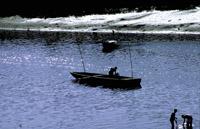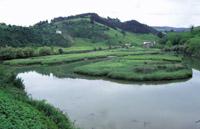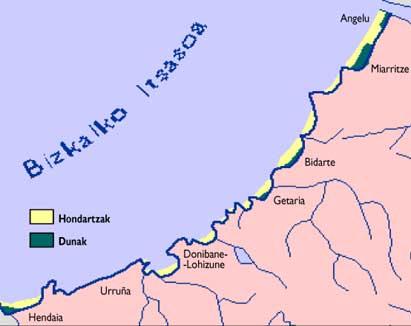Wetlands of the Basque Country (IV): Coastal wetlands
2000/08/01 Estonba Mintxero, Mikel Iturria: Elhuyar aldizkaria
In this unique ecological framework, wetlands are only a small part of the territory, since by the characteristics of the Basque orography they are not abundant or of great extension. However, from the ecological point of view, the wetlands of the Basque Country are the reflection of the climate, geological and orographic diversity mentioned above, and that throughout our geography you can see numerous types of wetlands.
According to the geological and geographical characteristics of the different wetlands, the wetlands of the Basque Country can be classified as:
Coastal wetlands
- Rías and marismas
- Coastal lagoons
Internal wetlands
- Mountain wetlands
- Peatlands Peatlands
- Lakes of glacial origin
- Karst wetlands
- Endorheic lakes
- Wetlands associated with rivers
- Artificial wetlands
In the following articles we will try to know the origin, characteristics, flora, fauna and the most significant examples of each of these types of wetlands in the Basque Country and their conservation status.
Coastal wetlands Rías and marismas
In the Basque Country, estuaries or estuaries that form at the mouth of all the rivers that reach the sea are ancient river valleys that were affected by marine tides at the end of the last glaciation due to the increase in the sea level. The confluence between the sea, the river and the terrestrial environment in the estuaries makes complex, dynamic, eutrophic and highly biodiverse wetland ecosystems develop.
The rías are characterized by their high level of production. To all the reasons indicated in the estuaries, in general for eutrophic wetlands, we must add the richness of mineral and organic foods derived from the interaction between the sea and rivers, the effective and rapid distribution of all these foods thanks to the dynamics of marine tides and their rapid assimilation and recovery. All these characteristics make that in the rías complex and very rich food chains are formed. The best known testimonies of this prosperity are the abundant and varied communities of native fish and birds.
However, despite being exceptional from the nutritional point of view, their living conditions are very hard, since in addition to the instability of the substrate and the scarcity of oxygen, the constant fluctuations of water and salinity due to marine tides are unsustainable for most of the living. In order to deal with these harsh conditions, the animals and plants that inhabit have had to develop special adaptations that have become highly specialized species to live in these media.
We will not go deeper into this type of wetlands, since it has already been sufficiently analyzed in this magazine Elhuyar Zientzia eta Teknika, both in the collection that I myself have written on the coast of the Basque Country, from February to April 1995 (numbers 92, 93 and 94), as in the specimens of June and July and August 1996 (numbers 108 and 109) written by Fernando Villate on estuaries.
Coastal lagoons
Part of the Basque coast from Cabo de San Martín de Biarritz to the mouth of the Atturri River is a continuation of the sandy coast of the Landes. There are elements typical of the sandy coasts: wide beaches, mobile dunes and behind them coastal lakes created by the dynamics of these coasts. The small coastal lagoons that appear at this end of the Basque coast are the simplest representatives of a set of lagoons that extends along about 200 kilometers of the coast of the Landes, so they have passed by surprise. But in Landeta, although the importance of these small lagoons is null, in Euskal Herria the situation is different, since they are the only examples of this type of wetlands in Euskal Herria.
To understand the formation of these coastal lagoons, about 10,000 years ago we have to go back. Then, at the end of the last glaciation called W> rm, large amounts of ice melted, causing an increase in sea water level. This ascent, known as Avanza Flamenco, provoked not only the creation of the current estuaries on the cliffs coasts, but also the slowdown of the spill of the rivers that reached the sea on the sandy coasts, giving rise to the appearance of swampy areas in their finals. Later, about 3,000 years ago, the coastal currents called derivas and the effect of the wind formed the bars of sand and mobile dunes, one of the most representative elements of these coasts, that displaced towards the interior, closed the rivers and appeared the coastal lagoons that we know today.
Due to this origin, the coastal lagoons present a particular morphology. In the rest of the types of lakes, although normally the zone of greater depth is the center of the lagoon, in the littoral ones the zone of greater depth is usually that of the dunes. However, towards the interior of the lakes the slope is softened, so the water connects gently with the earth. This singular morphology allows the development of four different types of natural spaces around the lagoons: the dune ecosystem that develops on deposits of sand, the ecosystem of open waters, the ecosystem of the margins with greater development in the interior end of the lagoons and the development of the forests that surround the lagoons.
Vegetation vegetation vegetation vegetation vegetation vegetation vegetation
The abundance of the different natural means surrounding the coastal lagoons and the contrast between the western and eastern margins, makes a small extension of a high plant richness. In addition, the physiological and morphological adaptations presented by autochthonous plants to address the living conditions imposed by each medium, allow the growth of several plant species considered of high evolutionary and ecological value.
To the west is the line of mobile dunes from Biarritz to the mouth of the Garonne River. The living conditions of these mobile dunes are very hard, since the erosive effect that produces the movement of the sand on the tissues of life, as well as the burial and sudden outcrops that it produces, we must add the high atmospheric salinity of these zones, the high permeability and sunny soil. To deal with these living conditions, various species of plants known as psammophilos have developed diverse adaptations as radical systems of great development for substrate retention and the search for water, fatty tissues to combat salinity, abundance of hairs to reduce the incidence of insolation or cylindrical stems and reservoirs to avoid burial and continuous outcrops. Among the plants present in these dunes are Ammophila, Honckenya peploides, Cakile maritima, Medicago marina, Pancratium maritimum, Calystegia soldanella, Eryngium maritimum, etc.
After the dunes appear the open waters of greater depth, so there is no vascular vegetation in this area. As we approach the eastern edge, the depth is gradually decreasing, which normally makes all the vegetable wars of the transition from water to land appear. The high specialization of the vegetation adapted to the different levels of humidity, the high diversity of species in reduced surface and the high ecological value of these species, from the botanical point of view, make the coastal lake a really interesting environment.
In this gradual transition we can find the following species: Aquatic plant species such as Lobelia dortmanna, Myriophyllum alteriflorum, Hippuris vulgaris or Nymphaea alba; amphibious plant species such as Ptychotis thorbellei, Hottoria palustris, Sparganium ramosum, etc., which can withstand periodic overflows of water but which amphibious vegetables such as gunpowder
Fauna and fauna Fauna of the Andes
It is not surprising that areas with this type of environmental diversity and plant richness have a varied and abundant fauna. In this brief article it is not possible to make a detailed description of the animal richness of the lagoons, so we will describe it in general.
As in the case of vegetation, the description of the fauna is also initiated by the dunes that extend on the western shore of the lagoon. For the same reasons we have mentioned for the plants, the dunes are not an ideal means for animals, but there are animal species that have adapted to live in these harsh conditions. The insect excavator species that inhabit mobile dunes such as Polyphilla fullo, Cicindella campestris, Chrysomela sanguinolenta or the Broscus cephalotes coleoptera stand out; the dermaptero Labiduria riparia or the hymenoptera Ammophila sabulosa and Oxybelus uniglumis. Also noteworthy are some species of gastropod of the genus Theba pisana, Cernuella virgata and Cochlicella.
As for open waters, the abundance of aquatic vegetation allows to maintain stable populations of fish. In the deepest areas, carnivorous species predominate, such as pike, perch or luxury. In addition to fish, the food wealth of these systems attracts numerous aquatic birds. Aquatic species of birds like cercetas, ducks, divers, copetazurias... serve as a place of recreation to feed the chain of littoral lakes of the Landes in their migratory or winter seasons.
Since the zones of the margins are in a more favorable situation for the development of the fish fauna, the diversity of species of fish is greater due to the presence of cyprínides such as gobio, escardinía or zamoa, in addition to the aforementioned species. Also on the shores, the different species of amphibians have a good state of subsistence, since amphibians are necessary for the reproduction of water. As for birds, on the shores are numerous species of waterfowl. In the areas where carriages and dense vegetation develop, inhabit carrizales, carrizales, spigons, hens of water, skyscrapers, agachadares... In the areas with beaches of limos and herbaceous vegetation, however, you can observe numerous species of limestones (slides, chorlitejos, brandales, kurlintas...).
Lagoons in Euskal Herria
From Cabo de San Martín de Biarritz to the mouth of the Atturri River, on the sandy coast of the Basque Country, we find three coastal lagoons. Two of them are located in the area called Barre, next to the current mouth of Atturri, and the third, Txiberta, in the center of the homonymous neighborhood built after the dune line of Angelu. The three are of small size and are quite altered by human activity. That of Chiberta, consequence of the tourist growth of the area in recent years, has been totally urbanized. In the western end is the golf course and in the oriental a park built for the neighbors of the neighborhood. Therefore, the riverside vegetation and fauna of this type of wetlands has completely disappeared and the fact that the water space of the lagoon is dedicated to leisure activities has made its natural characteristics reduced to a minimum.
However, the lakes of Barre are closer to the urbanized area, which has allowed them to stay in a more natural state. However, until a few years ago, these two lagoons were inside the hippodrome of Angelu, which caused many transformations. Now there is no racecourse and, therefore, on the shores of lakes there are small forests of one thousand, willows, alder and maritime pine. On the western margins, however, the urbanization of this area has caused the almost disappearance of the dunes.
Facing the future, we cannot be encouraging. Taking into account the lack of environmental sensitivity that the City of Angelu has shown so far in this stretch of sandy coast and the scarce importance that these small lagoons have at the level of the Aquitaine region, we hope that for a long time they will not stay this way. We have to remember the Pharaonic development project that until recently the City of Angelu wanted to build in it the marina dock or recently the Pharaonic development project for the environment of Barre.
The future of these few Basque coastal lagoons is really dark.

Gai honi buruzko eduki gehiago
Elhuyarrek garatutako teknologia





